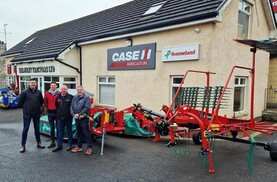A number of farmers in Fermanagh have highlighted concerns about the impact of leatherjackets on grassland this spring and early summer.
One farmer outside Belleek, who sent in a picture of his silage ground (right), reckons he has 50 acres badly impacted by the pest.
“There are 15 acres in that silage field, and there won’t be 15 bales on it. It is going to cost me thousands. I’m going to be down 250 to 300 bales overall,” he maintained.
Another said that he had land taken at £140/acre for silage, and it has been badly hit.
“We were told to roll the ground at night when the grubs come to the surface. I have now rolled it twice and it has made no difference. It’s not exactly ground that you should be rolling at all, never mind twice in the spring,” he said.
Farmers in the area have been left with no effective means of controlling leatherjackets (the larvae of daddy long-legs) since chlorpyrifos products (Dursban) were withdrawn from sale in 2016.
The adult daddy long-legs emerge in late summer/early autumn and lay their eggs in grass a few weeks later.
The resultant larvae feed on roots and underground stems during the day, and plants above the ground at night. They cause most damage in the spring months.
One potential reason for leatherjackets to be causing more issues this year relates back to wet conditions last August when farmers in the west struggled to graze out swards. The daddy long-legs are known to prefer laying their eggs in long grass.
AgriSearch
In March 2021, farmer funded research body AgriSearch confirmed that it would be working alongside staff in AFBI and four farmers in Fermanagh on a new project investigating the challenge of controlling leatherjacket populations in grassland.
It is hoped that the results of the project will highlight simple strategies to help prevent infestations of leatherjackets on farms across NI.
Read more
Leatherjackets back with a vengeance
Cultural leatherjacket control proves a success
A number of farmers in Fermanagh have highlighted concerns about the impact of leatherjackets on grassland this spring and early summer.
One farmer outside Belleek, who sent in a picture of his silage ground (right), reckons he has 50 acres badly impacted by the pest.
“There are 15 acres in that silage field, and there won’t be 15 bales on it. It is going to cost me thousands. I’m going to be down 250 to 300 bales overall,” he maintained.
Another said that he had land taken at £140/acre for silage, and it has been badly hit.
“We were told to roll the ground at night when the grubs come to the surface. I have now rolled it twice and it has made no difference. It’s not exactly ground that you should be rolling at all, never mind twice in the spring,” he said.
Farmers in the area have been left with no effective means of controlling leatherjackets (the larvae of daddy long-legs) since chlorpyrifos products (Dursban) were withdrawn from sale in 2016.
The adult daddy long-legs emerge in late summer/early autumn and lay their eggs in grass a few weeks later.
The resultant larvae feed on roots and underground stems during the day, and plants above the ground at night. They cause most damage in the spring months.
One potential reason for leatherjackets to be causing more issues this year relates back to wet conditions last August when farmers in the west struggled to graze out swards. The daddy long-legs are known to prefer laying their eggs in long grass.
AgriSearch
In March 2021, farmer funded research body AgriSearch confirmed that it would be working alongside staff in AFBI and four farmers in Fermanagh on a new project investigating the challenge of controlling leatherjacket populations in grassland.
It is hoped that the results of the project will highlight simple strategies to help prevent infestations of leatherjackets on farms across NI.
Read more
Leatherjackets back with a vengeance
Cultural leatherjacket control proves a success






 This is a subscriber-only article
This is a subscriber-only article










SHARING OPTIONS: